Split Rock Studios created a series of thirty-eight paintings interpreting the Lewis and Clark Expedition’s journey. The large works hung for several years in a Sioux City, Iowa mall before being archived by the Lewis and Clark Trail Heritage, this site’s manager. Several paintings, photographed by Kristopher K. Townsend, illustrate pages on this website.
Pages with Paintings from Split Rock Studios
The Expedition’s Flags
by Joseph A. Mussulman

The expedition’s supplies included an unknown number of American flags. Those that the journals refer to only as being “of second size,” and “of third size,” were given to selected Indian leaders as tokens of peace.
July 14, 1804
Sudden storm
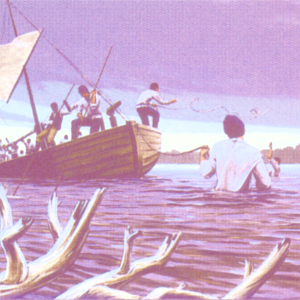

When they encounter a sudden storm, the men jump into the water to save the boats. An elk is wounded, and Lewis’s dog, Seaman, joins the chase. They encamp southwest of present Langdon, Missouri.
August 18, 1804
The Omahas arrive
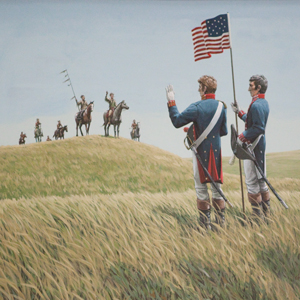

At Fish Camp near present Homer, Nebraska, the Omahas arrive for a council. Three Otoe chiefs witnessing deserter Pvt. Reed’s corporeal punishment ask for mercy, and Lewis’s birthday is celebrated.
August 19, 1804
Otoe's council, Floyd's illness
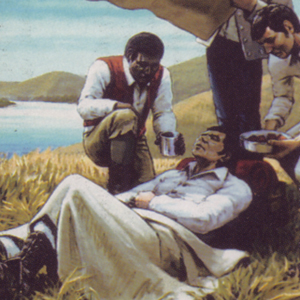

During a council at Fish Camp near present Homer, Nebraska, speeches with the Otoes are exchanged, but they appear dissatisfied with their gifts. Sgt. Floyd becomes seriously ill requiring urgent care.
September 7, 1804
Prairie dog town
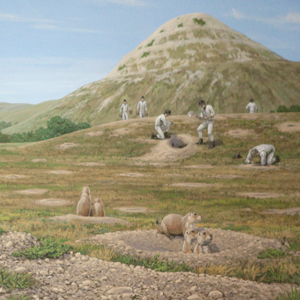

The captains climb Old Baldy—The Tower in present South Dakota. Everybody but the camp guard visits a prairie dog town, and they eventually catch one as a specimen. Pvt. Shannon is still missing.
September 25, 1804
Good humor left behind
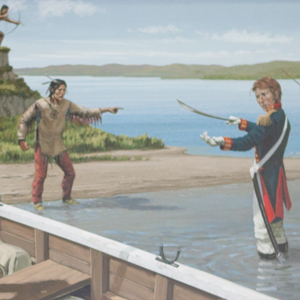

At Good Humor Island at present Pierre, South Dakota, a council with the Lakota Sioux brings diplomatic speeches, a military parade, and gifts. When the captains try to disembark, weapons are raised.
October 19, 1804
Gangs of buffalo
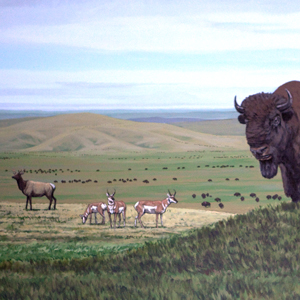

On their way to the mouth of the Little Heart River in present North Dakota, the expedition sees large herds of bison and elk, golden eagle nesting areas, and an abandoned Mandan village.
November 1, 1804
Looking for winter quarters
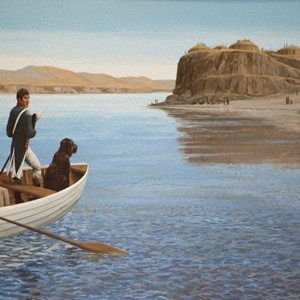

Lewis sends a letter and his British passport to a North West Company Fort and three Mandan chiefs visit. In the evening, Clark leaves to establish winter quarters and Lewis visits Mitutanka to get corn.
January 1, 1805
A new year at Fort Mandan


At Fort Mandan, New Year’s Day starts with rain and cannon fire. Several enlisted men are allowed to visit a nearby Mandan village, and Clark orders York to dance for them. The day ends snowy and cold.
January 8, 1805
Sgt. Ordway's visit
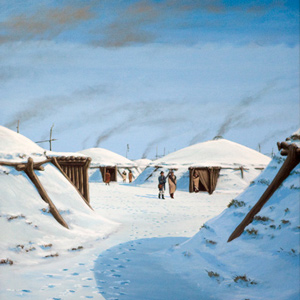

Braving a cold northwest wind, Sgt. Ordway visits a Mandan village, likely the one nearest Fort Mandan—Mitutanka. On the Ouachita River in present Arkansas, the Hunter and Dunbar Expedition turns back.
April 7, 1805
Leaving Fort Mandan


The permanent party leaves Fort Mandan bound for the Pacific Ocean. They make it only as far as Mitutanka, one of the Knife River Villages. In the barge, the return party heads towards St. Louis.
June 13, 1805
"sublimely grand specticle"


At the Grand Fall, Lewis marvels at the “sublimely grand specticle”. Downriver, Clark gives Sacagawea a dose of salts. At Fort Massac, General Wilkinson has questions about the people sent to him in the barge.
June 23, 1805
Portage route adjustments
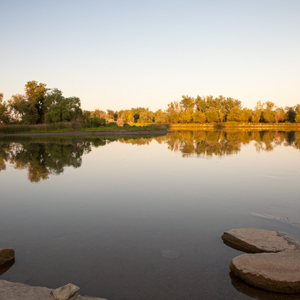

At the White Bear Islands, Lewis establishes an area to assemble the iron-framed boat. On the way back to the lower camp, prickly pears make walking difficult and the men suffer from fatigue.
August 29, 1805
Upper Village reunion
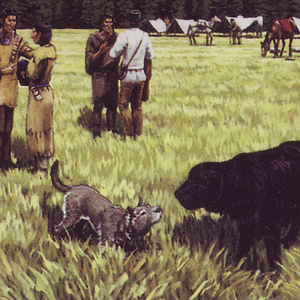

Clark travels to the Lemhi village where Lewis is trading for horses. He trades a pistol, 100 balls, powder, and a knife for a horse. Sgt. Gass describes sunflower bread and how the Shoshones make fire.
September 15, 1805
Up to Snowbank Camp
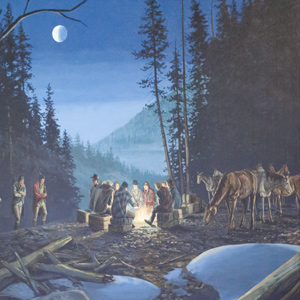

The corps travels down the Lochsa River and then takes a steep trail to return to the Northern Nez Perce Trail. On the climb, several horses slip and roll. They camp in an area with banks of old snow.
September 22, 1805
Bitterroot Mountain triumph
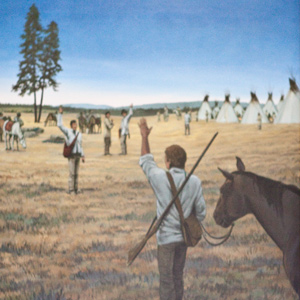

Lewis and the main party arrive at the Weippe Prairie villages “having tryumphed over the rocky Mountains”. Clark and Twisted Hair climb up from the Clearwater River and the two captains unite.
October 25, 1805
A "bad whorl & Suck"
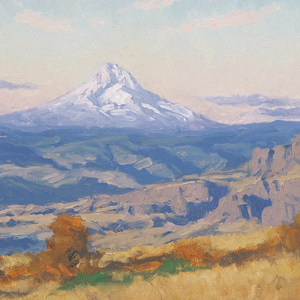

The expedition’s most valuable cargo is carried around the Long Narrows of the Columbia, and then the best paddlers run the canoes. At present The Dalles, Oregon, Fort Rock Camp is established.
November 19, 1805
A day at the beach


Clark’s group walks four miles up present Long Beach and sees a dead sturgeon and whale. At Station Camp near Chinook, Washington, one of the men trades his old razor blade for a Chinookan woven hat.
June 16, 1806
Return to Horsesteak Meadow


On the Northern Nez Perce Trail, fallen trees slow progress while deeper and deeper snowbanks appear. They encamp where Clark had shot a stray horse last fall. Lewis prepares two plant specimens.
July 16, 1806
Off to the Marias
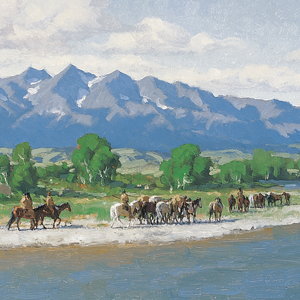

Lewis heads to the Marias River while Gass prepares wagon trucks above the Great Falls. Clark moves down the Yellowstone River by horse and Ordway paddles through the Gates of the Mountains.
July 27, 1806
Fight with the Blackfeet
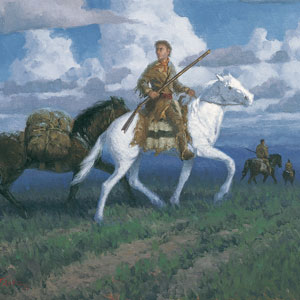

Lewis has a fatal fight with the Blackfeet, Ordway paddles down the Missouri, Gass takes horses to the Teton River, Clark paddles through the Yellowstone Badlands, and Pryor is stranded without horses.
August 13, 1806
All hands aboard
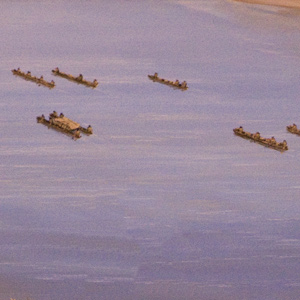

With all hands aboard, they start the day as one corps for the first time since separating on 3 July 1806. With favorable winds, they make eighty-six miles and pass the Little Missouri River.
August 17, 1806
An offer to raise Jean Baptiste
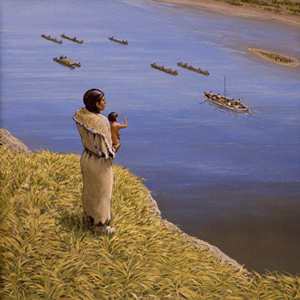

The expedition leaves the Knife River Villages without Pvt. Colter and the Charbonneau family. Clark encourages the Charbonneaus to come to St. Louis where he can arrange the education of Jean Baptiste.
September 4, 1806
Floyd's grave
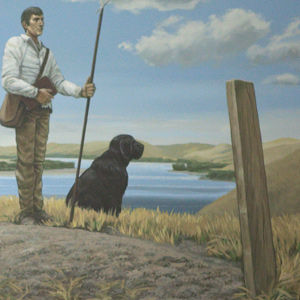

On a wet morning, the expedition sets out with ample tobacco and flour obtained from trader James Aird. They stop to visit Sgt. Floyd’s grave and camp early to dry out near present Dakota City, Nebraska.
September 21, 1806
St. Charles hospitality
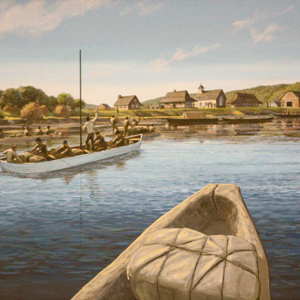

The boatmen paddle and row the 48 miles from La Charrette to St. Charles. They are greeted by the latter’s citizens with great cheer and hospitality. Lewis starts a letter to President Jefferson.
Experience the Lewis and Clark Trail
The Lewis and Clark Trail Experience—our sister site at lewisandclark.travel—connects the world to people and places on the Lewis and Clark Trail.
Discover More
- The Lewis and Clark Expedition: Day by Day by Gary E. Moulton (University of Nebraska Press, 2018). The story in prose, 14 May 1804–23 September 1806.
- The Lewis and Clark Journals: An American Epic of Discovery (abridged) by Gary E. Moulton (University of Nebraska Press, 2003). Selected journal excerpts, 14 May 1804–23 September 1806.
- The Lewis and Clark Journals. by Gary E. Moulton (University of Nebraska Press, 1983–2001). The complete story in 13 volumes.

